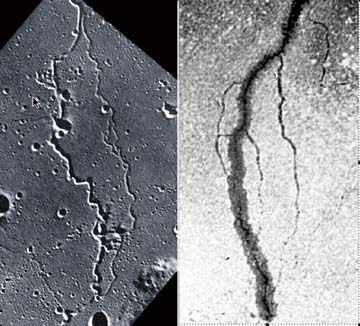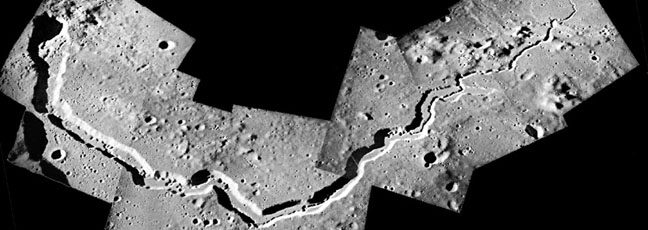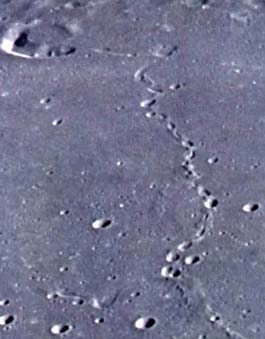- When the gods of antiquity went to war, all of mankind
was held rapt in terror. The titans towered over all of creation, blasting
one another with lightning and thunderbolts, and the earth shook and the
heavens caught fire. The sky was the theater of this terrible strife, and
to the observers below, it was the End of the World.
-
- These were the wars of the gods, as recounted in the
great epics of mythology. In his Theogony ("the origins of the Gods"),
the Greek poet Hesiod described Zeus in his battles with the titans. He
wrote, "For all the titans' might, the blazing flash of thunderbolts
and lightning blinded their eyes. Wondrous conflagrations spread through
chaos, and to eyes and ears it seemed as though what they saw and heard
was the collision of the earth and the wide sky above. For so vast a crash
could only arise if earth collapsed under collapsing sky, such was the
uproar of the battling gods."
-
- And who were the Greek gods battling in the heavens?
Greek astronomical traditions identified their greatest gods with PLANETS,
most notably Zeus with Jupiter, Kronos with Saturn, and Ares with Mars.
Given what we know about the planets today, these associations with "gods"
and cosmic upheaval can only appear ludicrous. In fact, astronomers 2500
years ago noted the clocklike patterns of planets. So why then did ancient
astronomers INSIST that in an earlier time, planets did not move on regular
and predictable paths?
-
- This was the profound question raised by Immanuel Velikovsky
more than 50 years ago. In his bestselling book Worlds in Collision, Velikovsky
argued that the planetary system as we know it today is NEW. He claimed
that as recently as a few thousand years ago, the earth itself was disturbed
by near collisions with other planets, and the result was the devastation
of ancient cultures the world over.
-
- Velikovsky was confident that the ancient celestial dramas
could be RECONSTRUCTED by identifying the points of agreement between the
ancient cultures. What Velikovsky found was a widespread human memory of
planets moving unpredictably and creating catastrophe.
-
- There is in fact a surprising consistency to the ancient
record. In his Timaeus, Plato speaks of "a destruction of the things
on the earth by fierce fire." He relates this world-altering catastrophe
to "a shifting of the bodies in the heavens, which move 'round the
earth." In the general Greek tradition, this "synodos"
or overwhelming catastrophe was caused by a disturbance or "collisions"
of planets. In the opinion of several experts (Franz Boll, Carl Bezold,
Wilhelm Gundel), "the flood, the conflagration of the world, and other
minor catastrophes were related to planetary motions and are to be interpreted
as the result of disturbances of the movements of the planets." (Sternglaube
Und Sterndeutung (Stuttgart, 1977), p. 93.
-
- We see surprisingly similar ideas in Taoist and Hindu
teachings, in Iranian tradition, and in early Chinese astronomical sources.
In the Iranian Bundahish, the "planets ran against the sky and created
confusion." In both the Chinese Bamboo Books and the Soochow astronomical
chart, great catastrophe occurred when the planets moved "out of their
courses."
-
- But Velikovsky was completely dismissed by the scientific
establishment. Astronomers claimed that Velikovsky had planets behaving
in a way that "defied the laws of gravity." And in a sense, they
were correct. Velikovsky did not share their confidence in the primary
role of gravity in solar system history. He believed that another force
electromagnetism once played a dominating role. And that, he
said, is why the ancient accounts described heaven-shaking THUNDERBOLTS
in the hands of the gods. Velikovsky was convinced that planets are charged
bodies, and in episodes of instability, near approaches of planets caused
devastating electrical arcs to pass from one body to another. These were
the thunderbolts of the gods.
-
- For several decades now, a number of independent researchers
have sifted through both the historical and the scientific evidence to
resolve the questions first posed in Worlds in Collision. Two of these
researchers, David Talbott and Wallace Thornhill, have devoted more than
thirty years each to this investigation. In Thunderbolts of the Gods, they
suggest that the space age has already vindicated Velikovsky, though no
one would know this from reading news releases in the scientific media.
-
- Numerous probes have sent back images of decimated planets
and moons. Every moon of the gas giants Jupiter and Saturn presents violently
sculpted surfaces, precisely the opposite of what astronomers had expected
of small bodies that had been "cold and dead" for billions of
years. Scientists remain baffled by the stark surface features on both
Mars and Venus, the two planets that figure most prominently in Velikovsky's
reconstruction. The chasm of the Martian Valles Marineris would swallow
hundreds of Grand Canyons, and would stretch from San Francisco to New
York. Its very presence defies every expectation of planetary scientists.
The planet Venus, a super heated cauldron with a surface temperature of
nine hundred degrees Fahrenheit, has been completely resurfaced by forces
the specialists still struggle to comprehend.
-
- Talbott and Thornhill suggest that it is not possible
to explain the surfaces of planets and moons today through any old paradigm.
They claim that all of the defining features of these bodies mimic the
scarring patterns of electrical discharge. It may appear as if "towering
volcanoes" rise from the surface of Mars, or that great volumes of
water cut the Valles Marineris. But as Talbott states, "It's only
necessary to look more closely. For instance, the great mound of Olympus
Mons, and the continental scale trench of the Valles Marineris, can now
be viewed in extraordinary detail. The old explanations fail, while the
electrical discharge hypothesis finds astonishing new support. This is
why we are urging that laboratory experiments with electric arcs be performed
to determine if what we are saying is true."
-
- On every rocky body we've visited with our probes, we
have encountered unexpected channels, called "rilles." Some are
merely grooves undulating across the surface, and others are highly complex.
But ALL, when studied closely in their geological context, pose insurmountable
mysteries for planetary scientists.
-
-

-
-
- Consider, for example, this simple rille on our moon,
shown on the left above. When geologists looked at the picture, they hastily
identified it as a channel cut by flowing lava. They did not stop to realize
that the "tributary" of the primary channel shows a feature that
is NEVER true of flowing liquid. The "tributary" connects with
the channel at BOTH ENDS! In electrical discharge, however, this is not
uncommon, as seen in the picture on the right a tract left by an
electric arc on a dusted metallic surface.
-
- But there is much more to this. Electric arcs can traverse
a surface in ways that are inconceivable for water -- disregarding elevation.
This mystery of lunar rilles was never resolved; they incessantly travel
up and down! An extraordinary example of this enigma is the Baltis Vallis
on Venus, extending at least 6800 kilometers across the planet's surface.
Scientists say it MUST be a lava flow, but are mystified as to how it retained
a consistent width (between 2 and 5 kilometers) along its entire length.
But even more mystifying is the vertical profile of Baltis Vallis, which
moves UPHILL and DOWNHILL dozens of times, with an incomprehensible range
of 2 kilometers from its highest to lowest points. (See Venus and the River
Styx.)
-
- Now look again at the picture of the electric arc above.
Notice that down the center of the primary channel, there is a virtually
continuous stream of small pits. A traveling electric arc is the only phenomenon
known to produce this feature.
-
- On a different scale, you can see the same stream of
pits in the 40-foot furrow cut by lightning across the infield of a baseball
diamond in the picture below.
-
-

-
-
- Now look at the river of small craters winding along
the great channel of Schröter's Valley on the Moon in the picture
below.
-
-

-
-
-
- Again, on seeing the stunning images of Schröter's
Valley, planetary scientists could only think of lava flows. They disregarded
the river of craters or pits, because they had no knowledge of electrical
discharge phenomena.
-
- To the electrical theorists, the true cause of "cratering"
in the solar system is so far from popular belief that an intellectual
revolution is required to understand it. The pictures returned by our space
probes have conclusively demonstrated that the force creating rilles is
the same force that has created the vast majority of craters on planets
and moons. Look at the lunar rille below, with its numerous craters centered
right on the channel, along with several elongated, scooped-out depressions.
The form of these craters is indistinguishable from the form of craters
in the close vicinity of the rille:
-
-

-
-
- Planetary scientists can only identify those craters
as "meteoric impacts." But in fact, way back in the 60's, an
amateur astronomer in England, named Brian Ford, noticed something very
interesting about lunar craters. He said that the ratio of large to small
craters matches the ratio seen in electrical arcing. Within the scientific
mainstream, no one followed up on this insight. But for the electrical
theorists, the pattern is only to be expected. Their laboratory experiments
with electrical scarring have shown surprising similarities to cratering
patterns in the solar system.
-
- One picture at Thunderbolts.info shows a complex of craters
produced by an electric arc. From the Picture of the Day, Craters in the
Lab: "This cratered surface duplicates many characteristics of planetary
geology. The craters tend to clump according to size, to fall in lines
and arcs. Notice also that the ground appears burnt or discolored where
the discharge was strongest and the craters the densest -- not unlike the
surface of Mars and other rocky bodies in the solar system. The centers
of some of the craters have raised bumps, as do many enigmatic craters
on the Moon, Mars, and other surfaces. Also of interest are the dark streaks
from two larger craters close to the center of the picture, a pattern similar
to the 'wind'-streaked craters found on Mars."
-
- Laboratory experiments have opened up a whole new opportunity
for understanding planetary history. The recent landings of the rovers
on Mars inspired one of the most revolutionary experiments to date. The
rover Opportunity sent back images of a reddish-hued landscape littered
with blue-grey spheres which planetary scientists called "blueberries."
Later, the rover Spirit found similar structures on the other side of Mars.
It is evident that countless spheres are embedded in the Martian soil.
Where these formations occur on Earth, they are called "concretions,"
and the electric theorists have for years expressed confidence that they
were produced in ancient times by electrical discharging.
-
- It was this claim that encouraged plasma physicist Dr.
C.J. Ransom to create a model of the Martian soil in his laboratory. The
soil in which the "blueberries" occur on Mars is an iron-rich
clay called hematite. In his very first experiment with an electric arc
in hematite, Dr. Ransom was amazed to see the small, blue-grey spheres,
impossible to distinguish from the pictures sent back by Opportunity.
-
- In the picture below, the image on the left (Frame A)
is of the Martian "blueberries," and the three color images in
the center (Frame B) are of the spherules produced in the laboratory discharge
experiment.
-
-

-
-
-
- Ransom's experiment has profound ramifications beyond
the Martian "blueberries." One of the well-known features of
electric discharge is its SCALABILITY meaning that what occurs on
a small scale also occurs on larger scales. The orbiting Themis cameras
found craters with domes or spheres resting within them. (See Frame C in
the picture above.) These are at a completely different scale than the
"blueberries," but look surprisingly similar. And the sizes range
from the smallest dimensions that can be discerned with the orbiting camera
(less than two hundred meters) up to greater than a KILOMETER in diameter.
If these craters were caused by meteors, the "spheres" are preposterous.
So the electrical discharge experiments have provided the ONLY scientific
explanation for them. The only reasonable conclusion is that both the "blueberries"
and the domed craters were produced by the same electrical force, acting
on widely different scales.
-
- The list of correspondences between laboratory discharge
effects and planetary surface features has been enumerated through a series
of "Pictures of the Day" on Thunderbolts.info. This includes
the looping channels cut across the global surface of Jupiter's moon Europa
, the traveling "volcanoes"
etching the surface of the Jovian moon , the highly filamentary hemispheric
channels on Saturn's moon Enceladus
, and the so-called arachnoids dominating the entire equatorial region
of Venus.
-
- Talbott and Thornhill tell us that these planetary scars
are the remnants of the ancient "wars of the gods," when planets
were immersed in electrical discharge, and exchanging cosmic thunderbolts.
All of the planets and moons were, from pole to pole, re-sculpted by violent
electrical activity. It is the pioneers of science who will follow the
evidence to its conclusion. Wherever it may lead, the picture of space
will be forever changed.
-
- ADDENDUM
-
- Dr C.J. Ransom's and Wallace Thornhill's paper on the
laboratory-generated spherules will be presented at the national meeting
of the American Phyiscal Society, in Tampa Florida, April 17, 2005. The
abstract is available at the APS website--
- http://absimage.aps.org/image/MWS_APR05-2004-000006.pdf
-
-
-
- Comment
- Structures On Planets And Moons From War?
- By Ted Twietmeyer
- tedtw@frontiernet.net
- 3-24-5
-
- Domes And Fused Globes - Planetary Wars?
-
- First, I must agree that electrical discharges can and
will cause molten globules. I did this 35 years ago with a Tesla coil and
steel wool. It is also hot enough to burn pin holes through the side of
a glass jar. We will also show that not all domes originate from electrical
arcs or wars.
-
- Globules, Domes, Trenches And Electrical Discharges
-
- To create such massive molten globules with electricity
on the surface of a planet or moon and be visible from orbit, could require
power levels easily in excess of one trillion watts we shall see. This
figure is easily derived by comparing observed effects of electrical discharges
which we will do later. Typical objects visible from space are 1 meter
or more in size, which often represents about one 1 pixel in a satellite
image. Optics can bring imaging to the limits of diffraction imposed by
atmosphere (or a remnant thereof) and other factors. We will explore the
power levels required to create these structures on a planet or moon surface.
-
- Electrical Discharge Effects
-
- The diameter of any electrical discharge is comparatively
small in relation to the length. An arc is a plasma, and requires a gas
to be present. On many moons no gas exists. The area melted into a molten
mass by a static discharge is determined by:
-
- 1. Material
- 2. Ambient temperature
- 3. Atmospheric effects
- 4. Actual current flow and voltage during the discharge
- 5. Duration of the discharge
- 6. Diameter of the arc
- 7. The surface area at the source end of the arc. This
can determine the maximum arc diameter depending on other conditions.
-
- AC and DC electricity provide a constant flow of current
at a given voltage. A battery is a good example. Static electricity is
an instantaneous event, and is never continuous. Even a static generators
like Van DeGraff or Whimhurst machines, require time to build up a charge.
A spark gap device is often used to initiate a discharge.
- Static electricity is without motion until discharge
takes place. It "resides" on surface of an object. Unlike battery
power, static can reside on either an insulator OR a conductor.
-
- An object isolated from the earth in motion such as an
airplane will also build up a considerable electrical charge. Airplanes
of all types are inherently insulated from the earth's surface by rubber
tires, just like your car or truck. When airliners are refueled a grounding
cable is always attached first to discharge the plane, to prevent sparks
from static electricity from igniting fuel vapors.
-
- Two planetary bodies in space passing very close enough
to each other with very large static potentials present, could arc to one
another until the charges on both moons or planets were neutralized. This
would be a random event that would not last long. Such arcs would also
randomly impact each body. This has not yet been observed to take place,
but well established laws of electricity state that it would. However,
two planets or moons passing this close to one another, would most likely
collide shortly after discharge. We do not yet know if earth's moon has
a static potential polarity with regard to the earth, as there is no way
to make such a measurement.
-
- Why Static Electricity Is Different
-
- Static electricity is considered an instantaneous event
and is the result of a discharge from a charged body or object. For example,
walking across a carpet and touching a doorknob. Although the actual voltage
can be up to 1 million volts or more, thankfully there is very little current
flowing with this voltage. When the difference in electrical charge between
you and the doorknob equalizes, the current flow drops off and the arc
extinguishes. Static electricity is created by the tribolelectric effect,
and can be stored in a capacitor.
-
- Since the length of this electrical pulse is very fast,
there is far less pain associated with it than one would expect. Nerves
require several milliseconds to respond to pain, and a static discharge
is near this time threshold. A 1/4 second electrical shock from a wall
outlet which is thousands of times lower in voltage than a static discharge,
is considerably more painful as most of us know. Discharging yourself through
your knuckle instead of your fingertip also hurts less.
-
- About Lightning
-
- Dale Electronics has been a manufacturer of spike and
lightning suppression devices and numerous other electronic components.
In the 1980's it was estimated lightning contained about 2 million volts
at 60,000 amps. Decades ago Dale introduced a circuit-breaker panel spike
suppression tube device. This could handle an electrical spike induced
in power lines, by rotating the arc around inside a gas filled tube wound
with a coil. (It couldn't survive a direct lightning bolt hit, but will
suppress spikes induced in power lines from lightning bolts.) Lightning
is classified as static electricity.
-
- Understanding Power And Energy Required To
- Create Structures On Planets And Moons
-
- Few people consider the problem of scaling up lightning
experiments in a laboratory, to create molten domes or spheres visibly
from orbit. Lightning bolts can create small jagged fulgurite structures.
These are frequently found in sand or sandy soil. If you are not familiar
with these, there are pictures for you here at http://www.gc.maricopa.edu/earthsci/imagearchive/fulgarites.htm
-
- Established lightning research performed in the western
USA on a mountain top has shown that the average lightning bolt is just
one-half inch in diameter. It appears much bigger because the eye is fooled
by the intensity. Also, note that fulgurite are not domed shaped, but are
random in structure.
-
- What would we need to create giant trenches, domes and
rills on moons and planets? To create these structures many miles long
as shown in the photos (above) requires a SUSTAINED, artificially-generated
power level far higher than ordinary lightning. If the power (a beam of
energy) was a pulsed discharge (as takes place with static electricity
generation) the trenches should show this and would not be continuous.
Trenches, rills and domes must be very, very large to be seen from orbit
at their apparent size shown. Formation of these structures doesn't completely
fit the water erosion model. The edges of the square walled trenches require
a well formed, controlled beam diameter.
-
- Domes - More Than One Type
-
- We can show it is patently wrong to categorize all domes
as created by electrical discharges. The image below shows a dimpled, well
structured dome currently located in a crater on Mars. I have included
this image below from NASA, which was never explained by them. NASA scientists
have always sided against any intelligent life forming any structures found
in our solar system, even though they claim to seek this out.
-
-

-
-
- Source:
- http://www.data4science.net/mars/buildings.html
-
- Without image processing and magnification the above
structure would have never been observed. And it would have been categorized
as just another dome of material. Since NASA cannot explain it away, they
are silent about it. I've shown these images to image processing scientists
myself, and they just fall silent. It's taboo to talk of outside intelligent
life, despite what the Drake Equation has to say about the certainty of
it.
-
- What is apparent however, is that an energy beam must
have been employed using some type of unknown technology to melt millions
of tons of moon or planetary material to create these structures and objects.
A war may or may not have been the reason for forming these structures.
It may also be the result of a form of planetary engineering as a way to
control the flow of water, to create boundaries for land regions or other
unknown purposes.
-
- It is also not known if any of these domes are HOLLOW,
which is also entirely possible.
-
- There may also be a "matter" beam type associated
with forming these rills, trenches and domes. Hypothetically, one type
of beam could cause material to be removed (forming trenches) and another
beam type causes material to form dome shapes or rills. In any case, the
image above seems to clearly convey some intelligent method of physical
construction.
-
- Perhaps we will know the truth one day in our lifetimes.
But I wouldn't count on NASA to tell us...
-
- Ted Twietmeyer
- http://www.data4science.net
-
-
- Response to Ted Twietmeyer
- From Michael Goodspeed
- 3-25-5
-
-
- Twietmeyer raises the issue of scalability in electric
discharge phenomena. But the most accomplished expert on such phenomena,
Anthony Peratt, following the work of Nobel Laureate Hannes Alfven, has
shown that plasma discharge structures are scalable up to GALACTIC dimensions,
and beyond. (See Thunderbolts of the Gods, Chapter I,
pages 19-21, http://www.thunderbolts.info/tb-book.htm)
-
- Twietmeyer wrote, "An arc is a plasma, and requires
a gas to be present."
-
- This statement could easily confuse a reader. It is plasma,
not inert gas, that makes the "electric universe" possible. Neutral
plasma has certain similarities to a gas, but the differences are profound,
and these differences give rise to the description of plasma as the fourth
state of matter, or the FUNDAMENTAL state of matter, making up 99.999%
of the known universe. Plasma is highly conductive, and electric currents
flowing through plasma produce STRUCTURES that cannot be achieved by any
other force in nature. Peratt's experiments, for example, have demonstrated
dozens of configurations that are unique to plasma discharge. This work
is going to have a mind-altering on the scientific community, because Peratt
has more recently shown that only a few thousand years ago, Earth itself
moved through a much more electrified environment than today. The very
forms he has documented in the laboratory were seen in the sky of our early
ancestors, who recorded them in meticulous detail - by the MILLIONS - on
stone. (See Plasma
on Stone,)
-
- A common misconception is the idea that the "vacuum"
of space precludes electric currents from flowing through the solar system.
But our solar system, like the visible universe as a whole, is teeming
with current-carrying plasma, distinguished by the presence of charged
particles. One obvious indicator of electric fields in space is the acceleration
of the solar wind. As charged particles explode from the sun, they continue
to accelerate outward past the planets. This is what electric fields do;
they accelerate charged particles.
-
- To understand the model of charged planets and moons
revolving around an electric sun, it is essential that one not get trapped
in concepts of static electricity. On the Thunderbolts Picture of the Day,
Of Pith Balls and Plasma, the distinction is made clear:
- "A common mistake when first trying to understand
the Electric Universe is to think in terms of electrostatics. Experiments
with pith balls in Freshman Physics Lab come to mindThe Electric Universe
model is based on electrodynamics. And not simply on Freshman Physics electrodynamics
from a textbook but on the electrical behavior of plasma as observed in
laboratories and by spacecraft. Understanding actual plasma behavior requires
rejecting familiar presuppositions: Bodies immersed in plasma aren't isolated;
they are connected by circuits. They often aren't at equilibrium; most
astronomical bodies are radiating energy because they are in unstable conditions
and are moving toward equilibrium. Currents in plasma contract into linear
filaments; and the force between filaments decreases linearly with distance,
which makes it the most powerful long-range force in the universe. Plasma
divides into cells that are separated by capacitor-like double layers;
and this ensures that plasma phenomena are characterized by conditions
of non-isotropy, discontinuity and inhomogeneity."
-
- If the electric theorists are correct, then no artificially
generated "energy beam" can compare to the power displayed by
the electric force in the heavens.
-
- This power of electricity is vastly greater than commonly
recognized. Cosmologists continually toy with the gravitational force,
barely cognizant that the electric force is ten to the thirty-ninth power
(a thousand, billion, billion, billion, billion times) more powerful.
-
- Given what we now see in remote space, including coherent
discharge filaments and structures spanning LIGHT YEARS, the generation
of domes of a few hundred meters diameter is a trivial requirement.
-
- From this vast vantage point, the laboratory replication
of the Martian spherules ("blueberries") is of staggering significance,
which extends far beyond the presence of these BB-sized spheres on Mars.
Electric discharge does not care about size, and spheres of wide-ranging
dimensions occur even on the earth without explanation. (See "Martian
'Blueberries' in the Lab TPOD,).
|